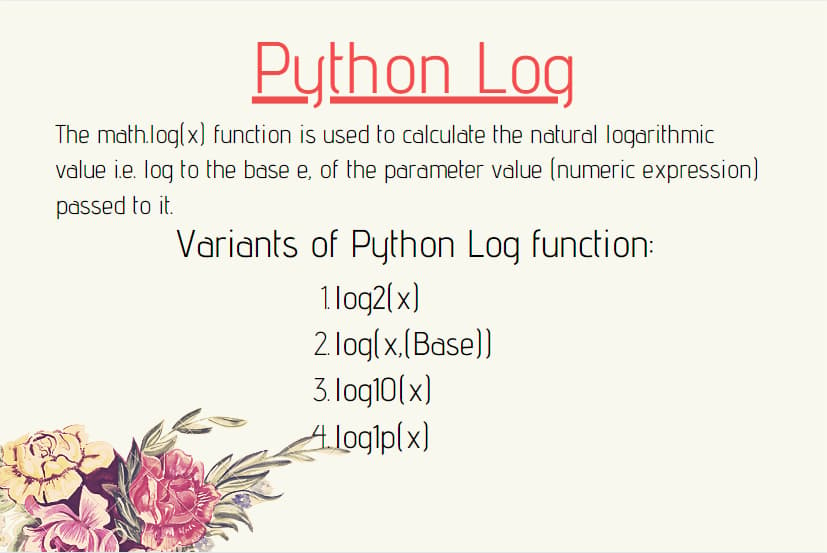- Log in to:
- Community
- DigitalOcean
- Sign up for:
- Community
- DigitalOcean
By Safa Mulani

Logarithms are used to depict and represent large numbers. The log is an inverse of the exponent. This article will dive into the Python log() functions. The logarithmic functions of Python help the users to find the log of numbers in a much easier and efficient manner.
Understanding the log() functions in Python
In order to use the functionalities of Log functions, we need to import the math module using the below statement.
import math
We all need to take note of the fact that the Python Log functions cannot be accessed directly. We need to use the math module to access the log functions in the code.
Syntax:
math.log(x)
The math.log(x) function is used to calculate the natural logarithmic value i.e. log to the base e (Euler’s number) which is about 2.71828, of the parameter value (numeric expression), passed to it.
Example:
import math
print("Log value: ", math.log(2))
In the above snippet of code, we are requesting the logarithmic value of 2.
Output:
Log value: 0.6931471805599453
Variants of Python log() Functions
The following are the variants of the basic log function in Python:
- log2(x)
- log(x, Base)
- log10(x)
- log1p(x)
1. log2(x) - log base 2
The math.log2(x) function is used to calculate the logarithmic value of a numeric expression of base 2.
Syntax:
math.log2(numeric expression)
Example:
import math
print ("Log value for base 2: ")
print (math.log2(20))
Output:
Log value for base 2:
4.321928094887363
2. log(n, Base) - log base n
The math.log(x,Base) function calculates the logarithmic value of x i.e. numeric expression for a particular (desired) base value.
Syntax:
math.log(numeric_expression,base_value)
This function accepts two arguments:
- numeric expression
- Base value
Note: If no base value is provided to the function, the math.log(x,(Base)) acts as a basic log function and calculates the log of the numeric expression to the base e.
Example:
import math
print ("Log value for base 4 : ")
print (math.log(20,4))
Output:
Log value for base 4 :
2.1609640474436813
3. log10(x) - log base 10
The math.log10(x) function calculates the logarithmic value of the numeric expression to the base 10.
Syntax:
math.log10(numeric_expression)
Example:
import math
print ("Log value for base 10: ")
print (math.log10(15))
In the above snippet of code, the logarithmic value of 15 to the base 10 is calculated.
Output:
Log value for base 10 :
1.1760912590556813
4. log1p(x)
The math.log1p(x) function calculates the log(1+x) of a particular input value i.e. x
Note: math.log1p(1+x) is equivalent to math.log(x)
Syntax:
math.log1p(numeric_expression)
Example:
import math
print ("Log value(1+15) for x = 15 is: ")
print (math.log1p(15))
In the above snippet of code, the log value of (1+15) for the input expression 15 is calculated.
Thus, math.log1p(15) is equivalent to math.log(16).
Output:
Log value(1+15) for x = 15 is:
2.772588722239781
Understanding log in Python NumPy
Python NumPy enables us to calculate the natural logarithmic values of the input NumPy array elements simultaneously.
In order to use the numpy.log() method, we need to import the NumPy module using the below statement.
import numpy
Syntax:
numpy.log(input_array)
The numpy.log() function accepts input array as a parameter and returns the array with the logarithmic value of elements in it.
Example:
import numpy as np
inp_arr = [10, 20, 30, 40, 50]
print ("Array input elements:\n", inp_arr)
res_arr = np.log(inp_arr)
print ("Resultant array elements:\n", res_arr)
Output:
Array input elements:
[10, 20, 30, 40, 50]
Resultant array elements:
[ 2.30258509 2.99573227 3.40119738 3.68887945 3.91202301]
Conclusion
In this article, we have understood the working of Python Log functions and have unveiled the variants of the logarithmic function in Python.
Thanks for learning with the DigitalOcean Community. Check out our offerings for compute, storage, networking, and managed databases.
Still looking for an answer?
- Table of contents
- Understanding the log() functions in Python
- Variants of Python log() Functions
- Understanding log in Python NumPy
- Conclusion
- References
Deploy on DigitalOcean
Click below to sign up for DigitalOcean's virtual machines, Databases, and AIML products.
Become a contributor for community
Get paid to write technical tutorials and select a tech-focused charity to receive a matching donation.
DigitalOcean Documentation
Full documentation for every DigitalOcean product.
Resources for startups and SMBs
The Wave has everything you need to know about building a business, from raising funding to marketing your product.
Get our newsletter
Stay up to date by signing up for DigitalOcean’s Infrastructure as a Newsletter.
New accounts only. By submitting your email you agree to our Privacy Policy
The developer cloud
Scale up as you grow — whether you're running one virtual machine or ten thousand.
Get started for free
Sign up and get $200 in credit for your first 60 days with DigitalOcean.*
*This promotional offer applies to new accounts only.
